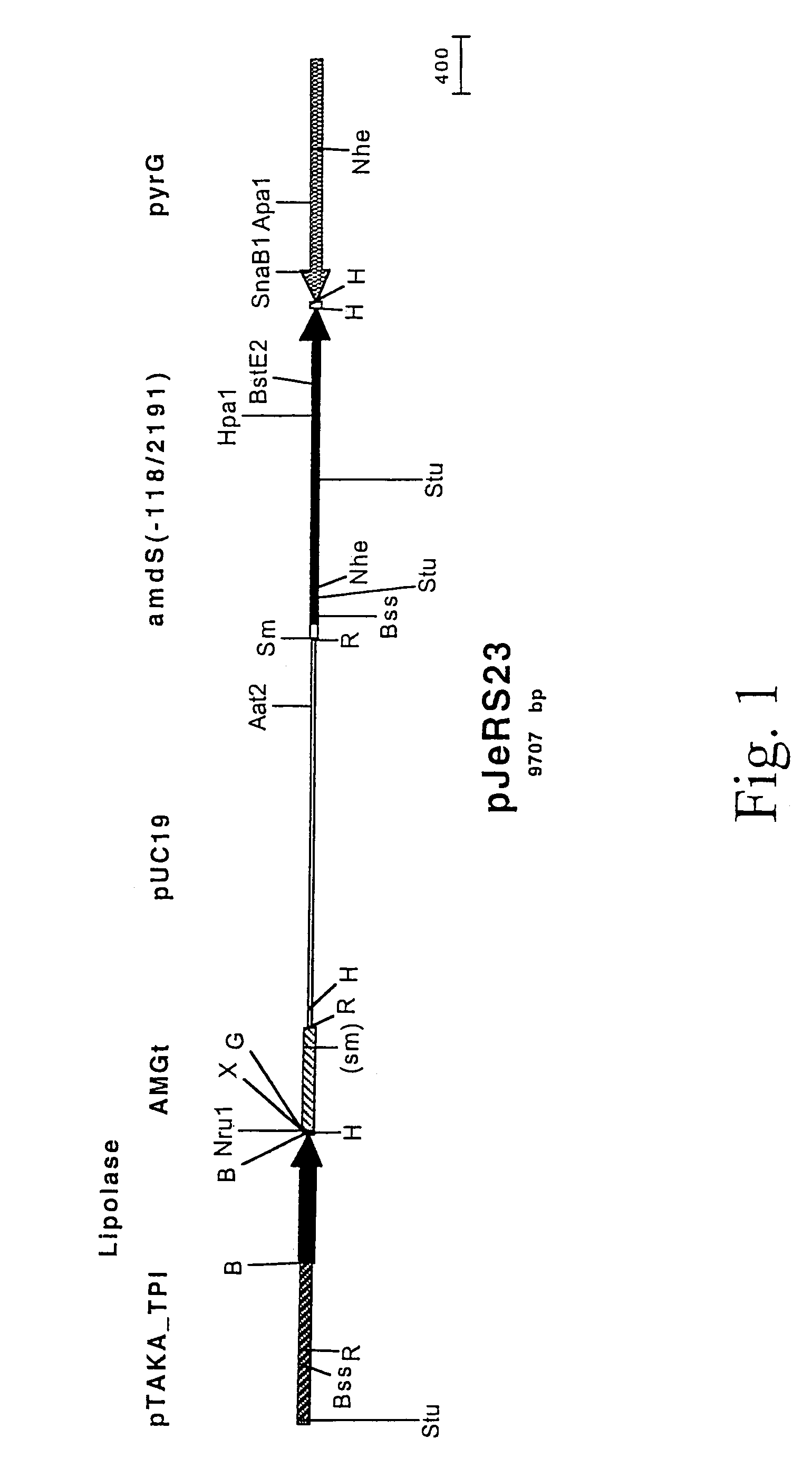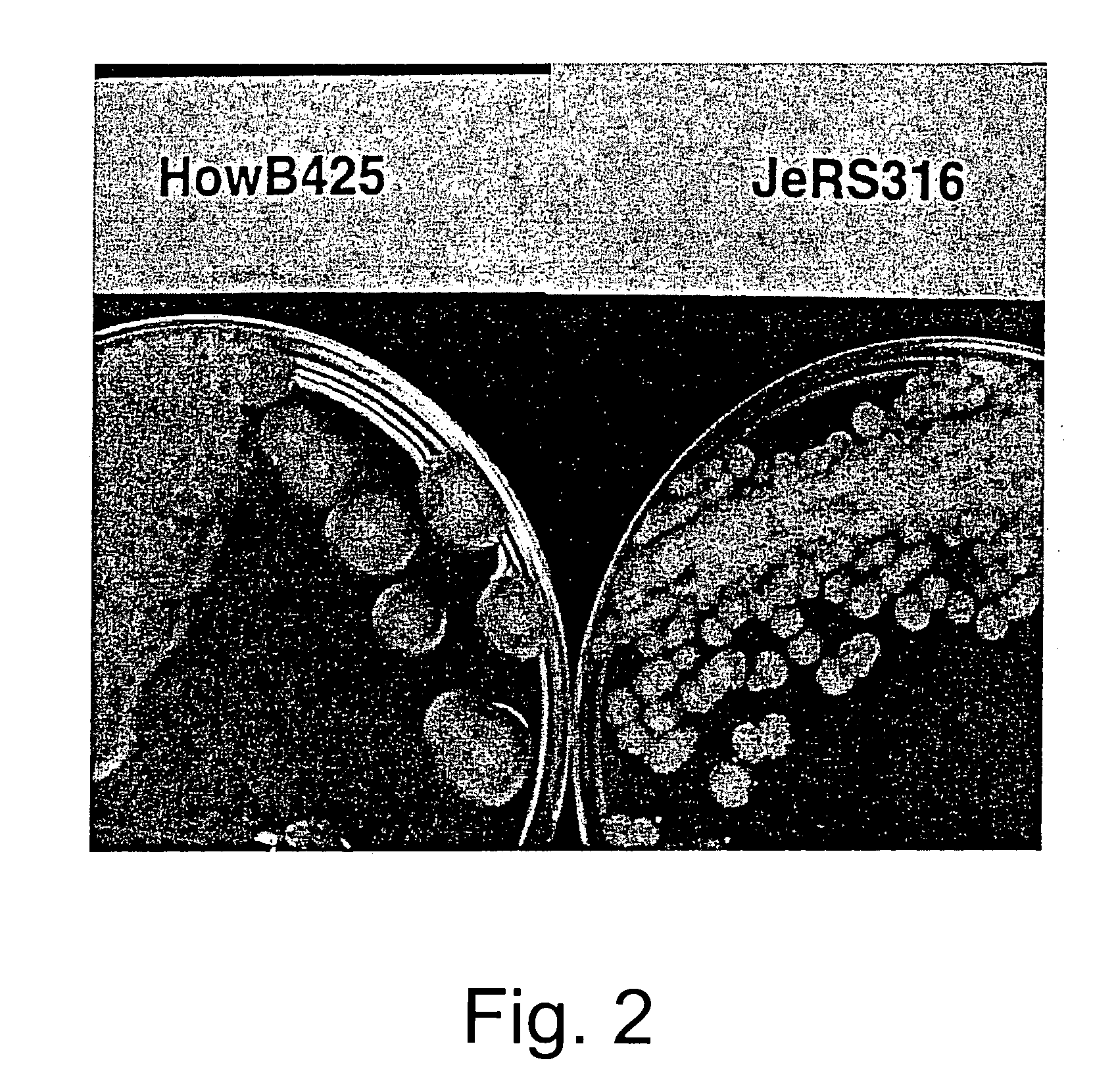Morphological mutants of filamentous fungi
a filamentous fungus and mutant technology, applied in the field of morphological mutants of filamentous fungi, can solve the problems of unsatisfactory growth morphology during fermentation, heterologous polypeptide expression not necessarily having the most desirable characteristics for successful fermentation, and fungi which have desirable traits, etc., to achieve extensive hyphal branching and restricted colonial phenotype
- Summary
- Abstract
- Description
- Claims
- Application Information
AI Technical Summary
Benefits of technology
Problems solved by technology
Method used
Image
Examples
example 1
Mutagenesis of Aspergillus oryzae strain HowB425
[0061]Aspergillus oryzae strain HowB425 spores are harvested from solid medium and suspended to a concentration of 2.2×107 / ml in 0.01% Tween 80. Five ml of spore suspension are pipetted into a 90 mm plastic petri dish and the spores are irradiated for one minute with ultraviolet light to approximately 5% survival. The mutagenized spores are kept in the dark for one hour and then plated to PDA+50 mg / l uridine plates.
[0062]The frequencies of spore color mutants obtained from this mutagenesis treatment are 8.8×10−5 for white and 5.9×10−5 for yellow spored mutants. A total of about 34,000 viable colonies (250 to 800 per plate) are screened visually for a restricted colonial phenotype. Eighty-eight restricted colonials are selected. The edges of the restricted colonies growing on the plate are examined under a microscope (200×) for a high mycelial branching phenotype. Thirty-six of the selected colonials are selected as having a more extens...
example 2
[0064]A map of the lipase expression plasmid pJeRS23 is shown in FIG. 1. pJeRS23 contains the amdS gene from Aspergillus nidulans from bases −118 to 2191 (relative to the ATG start codon), the pTAKA-TPI / Lipolase / AMGt lipase expression cassette from pMHan37, the Aspergillus oryzae pyrG gene, and pUC19 sequences.
example 3
Aspergillus oryzae Transformation
[0065]Cultures to be transformed are grown in 20 ml of 1% yeast extract-2% Peptone (Difco)-2.5% glucose at 37° C. for 16–20 hours with agitation. Each culture is mixed with 10 ml of 1.2 M MgSO4, and the mycelia are recovered by filtration on Miracloth (CalBiochem, La Jolla, Calif.) or by centrifugation, washed with 1.2 M MgSO4, and then resuspended in 10 ml of 5 mg / ml NOVOZYM 234 (Novo Nordisk A / S, Bagsvaerd, Denmark) in 1.2 M MgSO4. The suspension is incubated with gentle agitation for approximately one hour at 37° C. to generate protoplasts. Undigested mycelia are removed by filtration through a layer of sterile Miracloth. Protoplasts are recovered by centrifugation at 3600×g. They are then washed with 10 ml of ST (1 M sorbitol-10 mM Tris pH 7.5), centrifuged, washed with 10 ml of STC (1 M sorbitol-10 mM Tris pH 7.5–10 mM CaCl2), centrifuged, and then resuspended in 1.0 ml of STC. The concentration of protoplasts is determined and the final concent...
PUM
| Property | Measurement | Unit |
|---|---|---|
| temperature | aaaaa | aaaaa |
| pH | aaaaa | aaaaa |
| pH | aaaaa | aaaaa |
Abstract
Description
Claims
Application Information
 Login to View More
Login to View More - R&D
- Intellectual Property
- Life Sciences
- Materials
- Tech Scout
- Unparalleled Data Quality
- Higher Quality Content
- 60% Fewer Hallucinations
Browse by: Latest US Patents, China's latest patents, Technical Efficacy Thesaurus, Application Domain, Technology Topic, Popular Technical Reports.
© 2025 PatSnap. All rights reserved.Legal|Privacy policy|Modern Slavery Act Transparency Statement|Sitemap|About US| Contact US: help@patsnap.com



